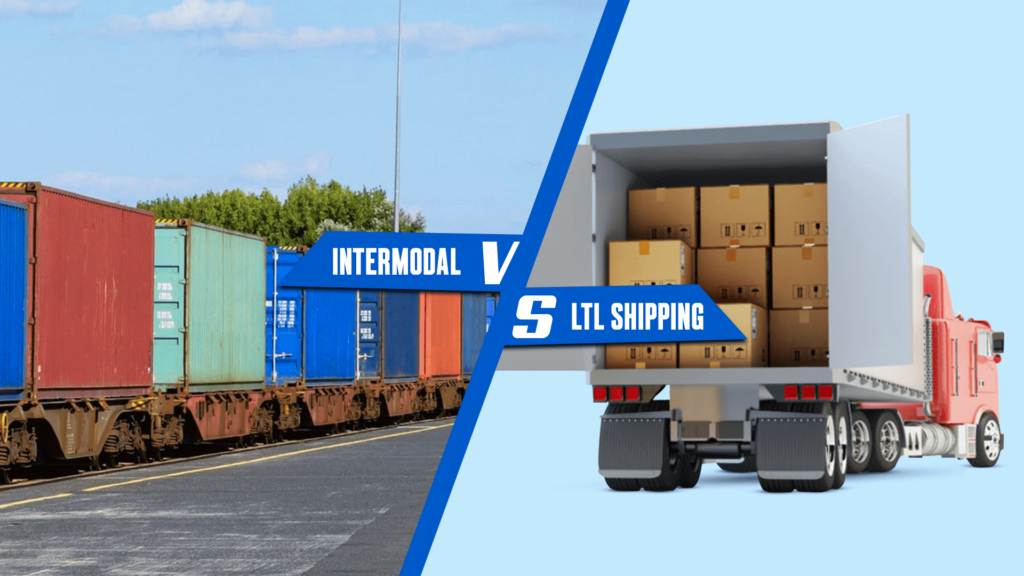Are you considering adding intermodal shipping to your logistics mix? But torn apart by the intermodal vs. LTL shipping debate?
This guide will equip you with basic knowledge about intermodal vs. truckload shipping and help you decide when to use which. Ensuring you choose the best option for your needs. Remember, there’s no one-size-fits-all solution, and the key to success is choosing the right approach for each situation.
Let’s dive in and explore the key differences to help you optimize your supply chain!
What Is Intermodal Transport?
Intermodal shipping utilizes trucks, trains, and ships in containers, for efficient movement of goods, both internationally and domestically. Which allows for cost-effective and time-saving solutions for long distances.
Check out this blog on Intermodal Transport for an in depth look.
What Is Truckload Shipping?
Truckload shipping utilizes large trailers to transport substantial freight volumes across long distances by road. These trailers boast impressive capacities, typically accommodating up to 45 pallets and 43,000 pounds of goods, with lengths reaching 48 to 53 feet.
This method prioritizes the exclusive transportation of your goods, eliminating the need for consolidation with other shipments. FTL offers the advantages of direct pickup and delivery with minimal handling, leading to increased efficiency and a reduced risk of damage.
Types Of Truckload Shipping
There are generally two types of Truckload shipping, they are –
- TL METHOD (TRUCKLOAD)
Truckload (TL), also known as full truckload (FTL), is a shipping method where your goods occupy the entire capacity of the truck trailer, either by volume or weight. This makes sure your shipment travels exclusively. Eliminating the need to be merged with other cargo.
- LTL METHOD (LESS-THAN-TRUCKLOAD)
Less-Than-Truckload (LTL) shipping is like a carpool for cargo! Instead of filling the entire truck, your shipment shares space with others heading in a similar direction. This translates to cost savings for everyone, as you only pay for the space your goods occupy and the distance they travel.
Whether you need speedy delivery or not, LTL offers an affordable and efficient option for smaller shipments.
These two topics are huge on their own, so today we will just be focusing on LTL comparisons only.
The Difference Between Intermodal And LTL Shipping
Confused about choosing between truckload and intermodal shipping? Knowing the difference helps you pick the best fit for your needs! Let’s break it down
- Flexibility
While generally cost-effective, intermodal shipping can be less flexible than truckload shipping. In the event of unexpected delays on the rail network, redirecting the freight for on-time delivery can be challenging.
This is because individual cars are normally locked onto the train and cannot be easily removed until they reach their final destination.
- Urgent Availability
For time-sensitive shipments, truckload shipping often emerges as the preferred option. This is because trucks can be readily available for immediate pick-up and delivery, eliminating the need for additional steps involved in intermodal shipping.
Intermodal transportation also requires the freight to be loaded onto a railcar, then transported by train. And at last, it has to be unloaded back onto the truck for final delivery, adding additional time to the overall process.
- Weight
Truckload and intermodal shipping containers might seem the same size, but truckload can hold a lot more. This is because the metal frame of an intermodal container is heavier than that of a regular truck trailer.
Think of it like this: a truckload trailer is like a strong pickup truck, while an intermodal container is like a strong wagon – it can hold a lot, but not quite as much as the truck.
- Scalability
Intermodal shipping offers greater scalability compared to truckload shipping. This is because truckload shipments are typically limited to the capacity of a single truck and driver for the entire journey.
In contrast, intermodal shipping can efficiently transport large volumes of goods by utilizing trains that can carry the average equivalent of 100 trucks simultaneously.
- Complexity
Truckload shipping might seem simpler, but intermodal shipping can handle much larger amounts of goods. While there are some behind-the-scenes complexities in intermodal (like dividing the journey into different segments). It all appears seamless to you as the shipper.
Just like with truckload, you only need to make one call, and the intermodal provider takes care of everything – coordinating the different segments of the journey and presenting you with a single invoice.
- Congestion
Too many trucks on the road? Intermodal shipping emerges victorious in the battle against congestion. This is attributed to the fact that a significant portion of the journey between origin and destination is completed on rail lines, effectively bypassing congested interstate highways.
This results in reduced traffic congestion and improved overall efficiency for the transportation system.
- Sustainability
Intermodal shipping shines as a leader in environmental sustainability due to its unique approach.
By using a combination of rail and truck transportation, intermodal shipping significantly reduces the number of vehicles on congested roads. Leading to cleaner air and reduced traffic.
Additionally, it utilizes resources more efficiently compared to traditional truckload shipping, minimizing waste generation. Furthermore, intermodal transportation boasts superior fuel economy, making it a more environmentally friendly choice.
As a result, businesses aiming for sustainability and seeking to minimize their environmental impact should strongly consider intermodal shipping as a compelling solution.
To sum up our above discussion for ease, here’s a table summarizing the overall thing –
| Feature | LTL method (less-than-truckload) | Intermodal |
| Flexibility | Less flexible, difficult to redirect in case of delays | More rigid due to fixed rail schedules |
| Urgent Availability | Readily available trucks for immediate pick-up and delivery | Requires additional steps like loading/unloading onto railcars, adding time |
| Weight Capacity | Higher weight capacity due to lighter trailer structure | Lower weight capacity due to heavier container frame |
| Scalability | Limited to single truck capacity | Can handle larger volumes using trains equivalent to multiple trucks |
| Complexity | Simpler process for the shipper | More complex behind-the-scenes but appears seamless to the shipper |
| Congestion | Contributes to road congestion | Reduces congestion by using rail lines for majority of the journey |
| Sustainability | Less eco-friendly due to higher fuel consumption and emissions | More eco-friendly due to efficient resource utilization, lower emissions, and superior fuel economy |
Conclusion
So, who wins the “Intermodal vs LTL shipping ” battle? It’s a draw! Each option has its own strengths, as you saw in the comparison table.
The key to success is matching the shipping method to your specific needs.
Sometimes, the choice might be very clear (e.g., urgent shipment needing immediate pickup – truckload wins!). In other cases, combining both methods for different situations or specific days might make the most sense. All the while keeping in mind “How to reduce shipping costs?”.
Still unsure? Don’t worry! We’ve got you covered. After you’ve weighed your options, the next step is to explore intermodal providers.
So, analyze your needs, explore your options, and choose the method that best fits the journey ahead!
FAQ
What Is Intermodal Shipping?
Intermodal shipping combines trucks, trains, and ships to move your goods. Everything fits snugly in special containers that easily switch between these different modes of transport.
What Does LTL Mean in Shipping?
TL shipping, also known as “less than a truckload” is like a carpool for your stuff! Instead of needing a whole truck, your shipment shares space with others heading in a similar direction. This makes it a good option for businesses that don’t have enough cargo to fill an entire truck, and is offered by both big national companies and specialized providers.
Is Ltl Faster Than Ftl?
Full truckload (FTL) shipping is typically faster and safer than LTL. Why? FTL uses a dedicated truck, taking a direct route with no extra stops or transfers. This means your goods arrive faster and with less risk of damage.
What Is Ltl Full Form?
LTL shipping, short for Less-Than-Truckload, is perfect for when you have smaller shipments that don’t fill an entire truck. It’s like carpooling for cargo! Multiple shipments from different businesses are loaded onto the same truck, making it a cost-effective option for smaller needs.
What Are The Two Types Of Intermodal Transport?
Intermodal shipping comes in two options: COFC(Container-On-Flatcar) uses separate containers on train cars, while TOFC(Trailer-On-Flatcar) loads entire truck trailers onto them. Both offer efficient ways to move large shipments.






